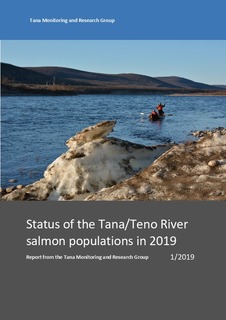Status of the Tana/Teno River salmon populations in 2019
Research report
Published version

Åpne
Permanent lenke
http://hdl.handle.net/11250/2634292Utgivelsesdato
2020Metadata
Vis full innførselSamlinger
Sammendrag
Anon. 2019. Status of the Tana/Teno River salmon populations in 2019. Report from the Tana Monitoring and Research Group nr 1/2019.
This report is the third status assessment of the re-established Tana Monitoring and Research Group (MRG) after the new agreement between Norway and Finland. After a summary of salmon monitoring time series in Tana/Teno, we present an updated status assessment of 15 stocks/areas of the Tana/Teno river system. All stocks are evaluated in terms of a management target defined as a 75 % probability that the spawning target has been met over the last four years. A scale of four years has been chosen to dampen the effect of annual variation on the status.
The map below summarizes the 2016-2019 stock status of the evaluated parts of the Tana/Teno river system. Symbol colour designates stock status over the last four years, classified into five groups with the following definitions:
1) Probability of reaching the spawning target over the last four years higher than 75 % and attainment higher than 140 % (dark green color in the summary map below)
2) Probability higher than 75 %, attainment lower than 140 % (light green)
3) Probability between 40 and 75 % (yellow)
4) Probability under 40 %, at least three of the four years with exploitable surplus (orange)
5) Probability under 40 %, more than one year without exploitable surplus (red)
Stock status over the last four years (2016-2019) was poor (probability of reaching management target <40 %) in 7 of the 15 stocks that we evaluated. The best status was found in Veahčajohka/Vetsijoki, Ohcejohka/Utsjoki and Báišjohka.
Of the stocks with poor status, the most important thing to note is the status of the upper main headwater areas of Kárášjohka, Iešjohka and Anárjohka/Inarijoki and of the Tana/Teno main stem.
These areas had low target attainment and low exploitable surplus. These four areas constitute 84 % of the total Tana/Teno spawning target and over the last four years, these areas together have lacked an average of 30 000 kg female spawners to reach their combined management targets.
One of the evaluated tributaries, Lákšjohka, was placed in the poorest stock status category due to three years of no exploitable surplus. Over the last four years, there were no exploitable surplus in 2017-2019 and all the coastal, main stem and tributary catch in these three years represent overexploitation of these two stocks. Of the other evaluated stocks, Anárjohka/Inarijoki and Iešjohka had no exploitable surplus in 2018 and 2019, and both were therefore now placed in the red category for the first time. Overexploitation was identified as a significant problem for the Kárášjohka, Iešjohka, Anárjohka/Inarijoki and Tana/Teno main stem areas.
Sonar counts from the Tana/Teno main stem in 2018 and 2019 give direct estimates of total run size and improve the estimated exploitation rates for both the Tana/Teno mainstem and the tributaries. Salmon ascending to the Iešjohka were counted using sonar for the first time in 2018.
Overall, a major result of the present status report is that the exploitation estimates show decreasing exploitation for all individual salmon stocks in the mixed-stock fishery in the Tana/Teno mainstem following the newly implemented agreement between Norway and Finland. The reduced exploitation rates for all stocks in need of recovery are sufficiently high to allow for recovery over two generations.
The table below summarizes the stock-specific management targets and status numbers for 2019 and previous four years, and the probability for reaching the spawning target over the previous 4 years (=the management target).